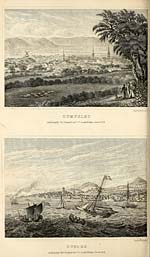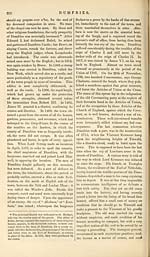Gazetteer of Scotland > Volume 1
(245) Page 215
Download files
Complete book:
Individual page:
Thumbnail gallery: Grid view | List view

DUMFRIES.
215
Feet above
the tea.
Queensberry Hill . . 2259
Black Larg, border of Ayrshire, 2890
Lowthers, near Wanlockhead, . 3150
IN ANNANDALE.
Annan Hill . . • 256
Repentance Tower . . 350
Brunswark Hill . . 740
Erickstane Brae . . 1118
Loch-skene . . . 1300
Hartfell . • • 2629
IN ESKDALE.
Mosspaul . 820
Langholm Hill . . 1204
Tinnis Hill . 1366
Wisp, in Ewes . . 1940
Etterick Penn . . 2220
— Population in 1821, males 33,572, females
87,306 ; total 70,878.
DUMFRIES, a parish situated in the centre
of the south-west border of the above county,
upon the left or east bank of the river Nith ;
extending about seven miles in length, between
the parishes of Caerlaverock on the south, and
Kirkmahoe on the north, and from two to
three in breadth, between the Nith (which di-
vides it from Troqueer in Galloway) on the
west, and the parishes of Tinwald and Tor-
thorwald on the east. The parish comprises
land of greatly various character. The whole
eastern division is simply the hopeless morass
called Lochar Moss ; the western, in which
Dumfries is situated, is excellent land, culti-
vated and planted in that high style which na-
turally obtains in the vicinage of a wealthy
town, and abounding in gentlemen's seats.
Dumfries, the capital of the county and
parish, a royal burgh, the seat of the synod
and presbytery of Dumfries, and, in a general
sense, the metropobs of the south-west quarter
of Scotland, is a handsome town on the left
bank of the Nith, about nine miles above its
efflux into the Solway ; distant from Edinburgh
seventy-one miles, from Glasgow seventy- two,
from Carlisle thirty- three, from Ayr sixty, from
Langholm thirty, from Lochmaben nine, and
from London, by way of Manchester, three
hundred and forty-one ; being situated, accord-
ing to Arrowsmith's map, in north lat. 55° 2'
45 ", and west long, from Greenwich, 3* 36. ;
At the present time, Dumfries is a thriving
t town, boasting of all the elegancies and attrac-
tions of a minor capital, and the constant re-
sidence of a vast number of titled and monied
occupants, who constitute among themselves
an exceedingly respectable circle of society.
It also boasts, in a commercial point of view,
of great importance as a market-town. In
early times, and even till a recent period, we
find Dumfries a place of much less note.
The originating cause of the town appears to
have been a strong castle, which flourished as
a border fortress during the twelfth century,
and which was often the object of contention,
in the times of "Wallace and Bruce in particu-
lar, between the Scots and English. Coeval
with this stronghold, and at no great distance,
was a church, which might also assist in at-
tracting settlers to the neighbourhood. The
etymology of the name is generally understood
to be, Drum, a ridge, and fries, shrubs; which
might be justified by the primeval character of
the situation ; but George Chalmers shows, in
his " Caledonia," that, the spelling of the name
having been Dunfres long before it was called
Dumfries, the etymology of it is more probably
Dun, a castle, and fries, shrubs, implying a for-
tress surrounded by furze. So early as the
reign of William the Lion, who died in 1214,
the place seems to have acquired a kind of
pre-eminence, as at that era it was the seat of
the judges of Galloway. It was probably du-
ring this reign that the town became a royal
burgh. At the middle of the thirteenth cen-
tury, the place must have acquired considerable
importance, as, otherwise, so great a public
work as the bridge on the Nith could not have
been built at this point. The founder of that
edifice, Devorgilla, mother of (King) John
Baliol, founded a monastery of Grey Friars at
Dumfries, which may also be accepted as a
mark of increasing consequence. At the al-
tar of the holy edifice, Robert Bruce, the rival
of her son, slew the Red Cumin, another of
her relations, February 10th, 1305. Edward
I. in the course of his incursions into Scot-
land, sometimes halted at Dumfries. Here,
by his command, the patriot Chrystopher Se-
ton was hanged. The scene of the disastrous
event is pointed out as being a mount to the
east of the town, then and previously the or-
dinary place of execution, or gallows-hiU, but
upon which the widow of the hero, Christian
Bruce, afterwards erected a chapel to his me-
mory ; her brother, king Robert, in 1324,
granted a hundred shillings yearly, out of the
barony of Caerlaverock, to a chaplain who
215
Feet above
the tea.
Queensberry Hill . . 2259
Black Larg, border of Ayrshire, 2890
Lowthers, near Wanlockhead, . 3150
IN ANNANDALE.
Annan Hill . . • 256
Repentance Tower . . 350
Brunswark Hill . . 740
Erickstane Brae . . 1118
Loch-skene . . . 1300
Hartfell . • • 2629
IN ESKDALE.
Mosspaul . 820
Langholm Hill . . 1204
Tinnis Hill . 1366
Wisp, in Ewes . . 1940
Etterick Penn . . 2220
— Population in 1821, males 33,572, females
87,306 ; total 70,878.
DUMFRIES, a parish situated in the centre
of the south-west border of the above county,
upon the left or east bank of the river Nith ;
extending about seven miles in length, between
the parishes of Caerlaverock on the south, and
Kirkmahoe on the north, and from two to
three in breadth, between the Nith (which di-
vides it from Troqueer in Galloway) on the
west, and the parishes of Tinwald and Tor-
thorwald on the east. The parish comprises
land of greatly various character. The whole
eastern division is simply the hopeless morass
called Lochar Moss ; the western, in which
Dumfries is situated, is excellent land, culti-
vated and planted in that high style which na-
turally obtains in the vicinage of a wealthy
town, and abounding in gentlemen's seats.
Dumfries, the capital of the county and
parish, a royal burgh, the seat of the synod
and presbytery of Dumfries, and, in a general
sense, the metropobs of the south-west quarter
of Scotland, is a handsome town on the left
bank of the Nith, about nine miles above its
efflux into the Solway ; distant from Edinburgh
seventy-one miles, from Glasgow seventy- two,
from Carlisle thirty- three, from Ayr sixty, from
Langholm thirty, from Lochmaben nine, and
from London, by way of Manchester, three
hundred and forty-one ; being situated, accord-
ing to Arrowsmith's map, in north lat. 55° 2'
45 ", and west long, from Greenwich, 3* 36. ;
At the present time, Dumfries is a thriving
t town, boasting of all the elegancies and attrac-
tions of a minor capital, and the constant re-
sidence of a vast number of titled and monied
occupants, who constitute among themselves
an exceedingly respectable circle of society.
It also boasts, in a commercial point of view,
of great importance as a market-town. In
early times, and even till a recent period, we
find Dumfries a place of much less note.
The originating cause of the town appears to
have been a strong castle, which flourished as
a border fortress during the twelfth century,
and which was often the object of contention,
in the times of "Wallace and Bruce in particu-
lar, between the Scots and English. Coeval
with this stronghold, and at no great distance,
was a church, which might also assist in at-
tracting settlers to the neighbourhood. The
etymology of the name is generally understood
to be, Drum, a ridge, and fries, shrubs; which
might be justified by the primeval character of
the situation ; but George Chalmers shows, in
his " Caledonia," that, the spelling of the name
having been Dunfres long before it was called
Dumfries, the etymology of it is more probably
Dun, a castle, and fries, shrubs, implying a for-
tress surrounded by furze. So early as the
reign of William the Lion, who died in 1214,
the place seems to have acquired a kind of
pre-eminence, as at that era it was the seat of
the judges of Galloway. It was probably du-
ring this reign that the town became a royal
burgh. At the middle of the thirteenth cen-
tury, the place must have acquired considerable
importance, as, otherwise, so great a public
work as the bridge on the Nith could not have
been built at this point. The founder of that
edifice, Devorgilla, mother of (King) John
Baliol, founded a monastery of Grey Friars at
Dumfries, which may also be accepted as a
mark of increasing consequence. At the al-
tar of the holy edifice, Robert Bruce, the rival
of her son, slew the Red Cumin, another of
her relations, February 10th, 1305. Edward
I. in the course of his incursions into Scot-
land, sometimes halted at Dumfries. Here,
by his command, the patriot Chrystopher Se-
ton was hanged. The scene of the disastrous
event is pointed out as being a mount to the
east of the town, then and previously the or-
dinary place of execution, or gallows-hiU, but
upon which the widow of the hero, Christian
Bruce, afterwards erected a chapel to his me-
mory ; her brother, king Robert, in 1324,
granted a hundred shillings yearly, out of the
barony of Caerlaverock, to a chaplain who
Set display mode to: Large image | Transcription
Images and transcriptions on this page, including medium image downloads, may be used under the Creative Commons Attribution 4.0 International Licence unless otherwise stated. ![]()
| Gazetteers of Scotland, 1803-1901 > Gazetteer of Scotland > Volume 1 > (245) Page 215 |
|---|
| Permanent URL | https://digital.nls.uk/97427302 |
|---|
| Description | Volume I: Abbey to Glenartney. |
|---|---|
| Attribution and copyright: |
|
| Description | By Robert Chambers and William Chambers. Glasgow: Blackie & Son, 1838. 2 volumes. |
|---|---|
| Shelfmark | NF.1461.g.7 |
| Additional NLS resources: | |

